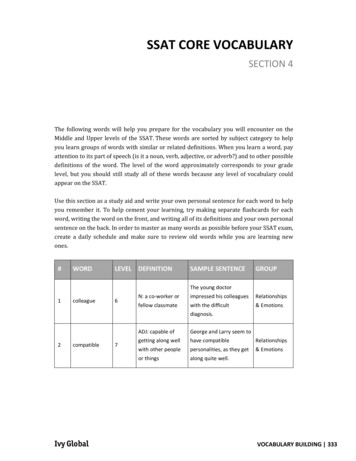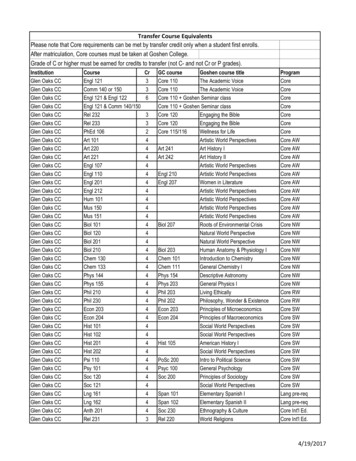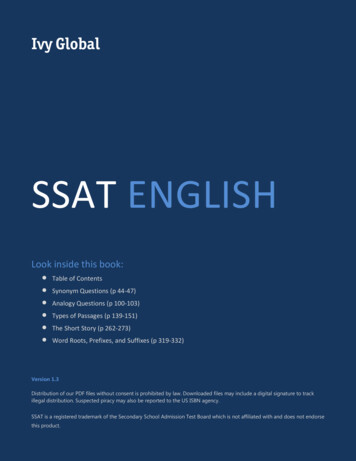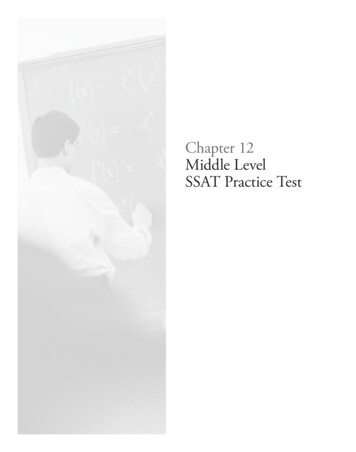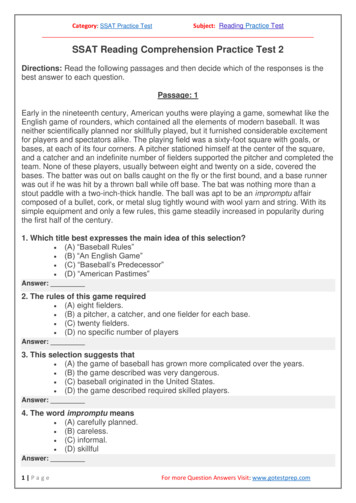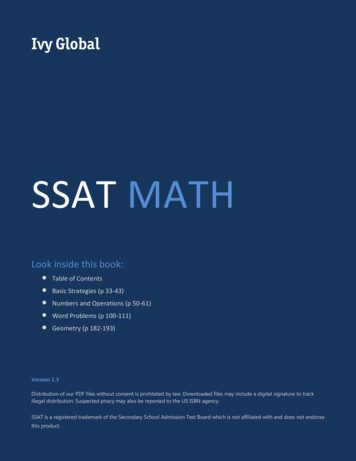
Transcription
Ivy GlobalSSAT MATHLook inside this book: Table of Contents Basic Strategies (p 33-43) Numbers and Operations (p 50-61) Word Problems (p 100-111) Geometry (p 182-193)Version 1.3Distribution of our PDF files without consent is prohibited by law. Downloaded files may include a digital signature to trackillegal distribution. Suspected piracy may also be reported to the US ISBN agency.SSAT is a registered trademark of the Secondary School Admission Test Board which is not affiliated with and does not endorsethis product.
CONTENTSChapter 1: Introduction . 1How to Use this Book . 3About the SSAT . 5Chapter 2: Test-Taking Strategies . 11Approaching the SSAT . 13Chapter 3: Math Strategies . 29Introduction . 31Basic Strategies . 33If You Get Stuck . 38Chapter 4: Math Review . 45Introduction . 47Part 1: Arithmetic . 49Numbers and Operations . 50Factors and Multiples . 68Fractions . 75Ratios . 82Decimals . 87Percents . 93Word Problems . 100Negative Numbers . 107Exponents and Roots . 112Order of Operations . 117
Part 1 Review . 120Part 2: Algebra . 133Basic Algebra . 134Expressions . 139Equations . 146Inequalities . 151Strange Symbols . 157Word Problems and Algebra . 161Part 2 Review . 167Part 3: Geometry . 181Lines and Angles . 182Polygons . 194Circles . 208Solid Geometry . 214Coordinate Geometry . 226Part 3 Review . 242Part 4: Data Interpretation . 257Charts and Graphs . 258Range, Mean, Median, and Mode . 270Probability . 277Part 4 Review . 286Chapter 5: Answer Keys . 303Arithmetic . 305Algebra . 316Geometry . 319Data Interpretation . 322
BASIC STRATEGIESSECTION 2Use this section to review some of the best test-taking strategies for the SSAT Math section.As you practice, keep in mind that not all problems are solved in the same manner. As astudent with your own unique learning style, you may also find that some strategies workbetter for you than others. Try out all of the methods below, and identify the strategies thatwork best for you.Most of the math questions on the SSAT are word problems, so your job is to find a way toconvert the wording of these questions into math concepts that you can recognize andsolve. When you first encounter a problem, use the following steps to get started.READ THE QUESTION CAREFULLYRead through the whole question. Don’t assume you understand the question just byreading the first few words! Reading the whole question will help you avoid makingassumptions that can lead to careless errors.If you see unfamiliar or difficult-looking material, stay calm and keep reading until the endof the question. There might be more information in the question that will help you figureout the solution. If you still think a question is too difficult after you have finished readingthe whole thing, then you should circle it in your question booklet, skip it, and come back toit if you have time. Don’t get anxious that you couldn’t solve a question; not every student isexpected to answer every question, and some questions might be beyond your grade level.Here is a simple example that we will work through to demonstrate these basic test-takingstrategies. Read the whole question carefully:MATH STRATEGIES 33
A triangle has three sides with lengths 3, 4, and 5. What is the perimeter of thetriangle?(A) 3(B) 7(C) 9(D) 12(E) 15UNDERLINE KEY WORDSUnderline or circle any information given in the question that will help you solve it. Ourexample question should now look something like this:A triangle has three sides with lengths 3, 4, and 5. What is the perimeter of thetriangle?IDENTIFY WHAT THE QUESTION IS ASKINGAsk yourself, “What is the question asking me to solve?” This is especially important forword problems. Sometimes the wording of a question can be confusing, so make it simplerfor yourself and summarize in your own words what the question is asking for.In our example question, you are being asked to find the perimeter of the triangle. This wasone of the words we underlined in the question. To remind yourself that this is what thequestion is asking, you might want to underline this word again:A triangle has three sides with lengths 3, 4, and 5. What is the perimeter of thetriangle?How would you explain the “perimeter,” in your own words? You might remember that theperimeter is the length of the outline of the triangle.DRAW A CHART OR DIAGRAMCharts and diagrams are great tools to help you visualize the problem and organize yourinformation. In our example question, you might try drawing a quick sketch of a triangle.Then, fill in any information you are given in the question. You can write in the lengths of allthree sides:MATH STRATEGIES 34
534COME UP WITH A STRATEGYStrategize the best way to solve the question. Sometimes finding the answer requires somethought if there are multiple steps involved. Think about all of the information provided inthe question and how it is related. Think about where you have seen this type of questionbefore, and what methods you have used to solve similar types of questions. If there is aformula that you know that could help, write it down.Here’s a strategy we could use to solve our example question. We know: the lengths of the sides of the triangle are 3, 4, and 5. We want: the perimeter, which is the length of the outline of the triangle. Our strategy: add up the lengths of all three sides of the triangle.Is our solution one of the answer choices? It is indeed! The answer is (D) 12.CHECK YOUR ANSWERAlways check your work to make sure that you picked the best answer among all of theoptions the SSAT gave you! Double-check all of your arithmetic to make sure that you didn’tmake any careless errors.Make sure that you solved for what the question was asking. For example, if the questionasked to solve for perimeter, make sure you didn’t solve for area.Try to determine whether or not your answer seems reasonable based on context. Forexample, if the length of one side of the triangle is 3, the perimeter cannot be 3, so answer(A) in our example is unreasonable.Finally, check that you bubbled in the answer on your answer sheet correctly. It would be ashame to have solved the question correctly and not get credit!MATH STRATEGIES 35
PUTTING IT ALL TOGETHERHere is another example question that is a bit more complicated. Use the same questionsolving steps to try it out.1. Read the question:The width of a rectangular field is one-quarter its length. If the length is 16,what is the perimeter of the field?(A) 4(B) 24(C) 36(D) 40(E) 642. Underline key words:The width of a rectangular field is one-quarter its length. If the length is 16,what is the perimeter of the field?3. Ask yourself, “What is the question asking me to solve?”Just like our first example, you are being asked to find the perimeter of therectangle. Put this in your own words: the perimeter is the length of the outline ofthe rectangle.4. Draw a diagram.Try drawing a quick sketch of a rectangle and fill in any information given in thequestion:width ¼ lengthlength 165. Strategize a solution.We know:We want: the perimeter of the whole rectangle.Our strategy: we can use a formula that relates a rectangle’s perimeter to its lengthand width.MATH STRATEGIES 36
()()We can now plug in the values and solve:()()If you did not remember this formula, look at the diagram again. To find the perimeter, weneed to add up the lengths of the four sides of the rectangle. Our sides include two lengthsand two widths, so here’s how we would add them up:There are often many different ways to solve a problem, so think creatively to find astrategy that works for you!MATH STRATEGIES 37
IF YOU GET STUCKSECTION 3If you are having trouble solving a problem mathematically, here are a few useful strategies.Try to use these strategies while doing practice exams so that you become familiar withthem.PROCESS OF ELIMINATIONIt is worthwhile to guess on a question if you can eliminate any answer options that youknow are wrong. So how do you eliminate wrong answers? Read the question and theanswer choices, and determine whether any of them seem unreasonable. For example:Which of the following fractions is less than 1/3?(A) 4/18(B) 4/12(C) 3/3(D) 12/9(E) 12/4Even if you forget how to solve the question above, you can eliminate wrong answers. Youknow that 1/3 is less than 1. Remember that an “improper fraction” has a numerator that isgreater than its denominator, and any improper fraction is greater than 1. Because answers(D) and (E) are both improper fractions, they must be greater than 1, so they can’t be lessthan 1/3. You can eliminate both of those choices right away.You might also remember that a fraction with the same numerator and denominator isalways equal to 1. Answer (C) has the same numerator and denominator, so it must beequal to 1 and can’t be less than 1/3. You can also eliminate answer (C).If you don’t know how to proceed with the arithmetic, you can guess between (A) and (B)and you will have pretty good odds of getting the correct answer. Or, you can look atanswer (B) and reduce 4/12 to 1/3. Because the question is asking for a fraction that is lessthan 1/3, (B) can’t be the correct answer. You are left with only one possible answer: (A).MATH STRATEGIES 38
GUESS AND CHECKSometimes you can narrow your choices down to one based on what seems reasonable, andthen check to see if this is actually the correct answer. This is often true with geometryquestions or problems where a diagram is given. For example:Julia arrived at Jenny’s house at 6:35 PM. Her mother picked her up at 8:04 PM. Howlong did Julia spend at Jenny’s house?(A) 29 minutes(B) 1 hour, 9 minutes(C) 1 hour, 29 minutes(D) 2 hours, 9 minutes(E) 2 hours, 29 minutesWe can guess an answer for this question by rounding the times. 6:35 PM is approximately6:30 PM and 8:04 PM is approximately 8:00 PM. The time between 6:30 to 7:00 is half anhour, and the time from 7:00 to 8:00 is another hour. Therefore, the time between 6:30 to8:00 is about an hour and a half.Looking at the answer choices, this is very close to (C) 1 hour, 29 minutes, so you can guessthat this is the right answer. If you’re running out of time, you might want to circle (C) asyour best guess and move on.In order to check that (C) is actually the right answer, subtract 6:35 PM from 8:04 PM:8:04-6:358 hours and 4 minutes is the same as 7 hours and 64 minutes. Use borrowing and re-write8:04 as 7:64 so you can subtract properly:7:64-6:351:29Our estimation by rounding was close to the actual answer, and our guess was correct.Now, try the guess-and-check method for a more challenging question:MATH STRATEGIES 39
Figure PQRS (drawn to scale) is a square with side length of 12. What is the area of theshaded region?PQ(A) 50(B) 72(C) 100(D) 120(E) It cannot be determined from the informationgiven.RSBecause PQRS is a square, its area is. We’re told that the diagram is drawnto scale, and it looks like that the shaded area is approximately half of the area of thesquare. Based on this estimate, let’s see if we can eliminate any answers that seemunreasonable. Answer (D) is too large, and so is (C). (A) seems too small because 50 isabout 1/3 of 144. (B) seems about right, so we can circle (B) as our best guess.Now we can check to see if (B) is actually correct. The area of the unshaded triangle is( )( )(). Subtract this from the area of thesquare to find the shaded area:.Our initial estimate was exactly right! If you were short on time and didn’t have time tocheck all of the calculations for this problem, you would have been correct with this guess.PICKING NUMBERSSometimes an algebra question may seem difficult or abstract because it contains a lot ofvariables—those letters or symbols that stand for numbers. The quickest way to solvethese questions is to simplify the algebra. However, you can also make any question moreconcrete by picking an easy number to work with and plugging in this number instead of avariable.The “picking numbers” method is typically used to solve questions whose answer choicesare algebraic expressions. For example, you might be asked to state someone’s age orheight “in terms of” variables, remainders, percentages, or fractions of variables. You mightalso be asked to determine whether an expression or variable is even or odd. Both of thesesituations are excellent times to use the “picking numbers” method. For example:MATH STRATEGIES 40
Michelle is 3 years older than Tommy. If Tommy is t years old, then how old isMichelle, in terms of t?(A)(B)(C)(D)(E)This example has variables in the answer choices, so we can use the “picking numbers”method. Pick an age for Tommy to replace t. Let’s pick 10. (You could have chosen anynumber.) If Tommy is 10 years old, Michelle is 3 years older than Tommy, so Michelle isyears old. The next step is to replace t with Tommy’s age (10) in each of theanswer choices:(A)(B)(C)(D) (E)If Tommy is 10 years old, we’ve already determined that Michelle must be 13 years old.Therefore, answer (A) is correct.Let’s try another slightly more challenging example:Nathan is three inches taller than Joseph, who is five inches shorter than Ethan. If erepresents Ethan’s height in inches, then how many inches tall is Nathan, in terms of e?(A)(B)(C)(D)(E)–This example has variables in the answer choices, so we can apply the “picking numbers”method. Let’s say that Ethan is 50 inches tall, so. (You can choose any number andthis method will still work. Try it!) If Ethan is 50 inches tall, we know that Joseph is fiveinches shorter, so Joseph isinches tall. Nathan is three inches taller thanJoseph, so he isinches tall.MATH STRATEGIES 41
The question is asking for Nathan’s height in terms of e. The next step is to replace e withEthan’s height (50) into each of the answer choices, and figure out which one matchesNathan’s height (48):(A)(B)(C)(D)(E)–We know that Nathan’s height is 48 inches when Ethan’s height is 50 inches, so answer (E)is correct.BACK-SOLVINGBack-solving is a method that allows you to work backwards from the multiple-choiceanswers you are given. Unlike the “picking numbers” method, you can only use backsolving if your answer choices don’t include variables. When your answer choices arenumbers, you can expect them to be given in order from largest to smallest or smallest tolargest. Take the middle answer (C) and plug it into your problem. If it works, it is right. Ifnot, you can usually determine whether to try a larger or smaller answer. For example:Two consecutive numbers have a sum of 13. What is the smaller of the two numbers?(A) 5(B) 6(C) 7(D) 8(E) 9Start with answer choice (C). If 7 is the smaller number, then the two consecutive numbersare 7 and 8, which have a sum of 15. The correct numbers must add up to 13, so we’relooking for a starting number that is smaller. We’ll try (B) next. If 6 is the smaller of the 2numbers, then the two numbers are 6 and 7, which have a sum of 13! (B) is the rightanswer.If (B) gave us a sum that was still larger than 13, we would have known that (A) wascorrect. If we started with answer (C) and it gave us a sum that was less than 13, our nextstep would have been to try answer (D).Here’s another more challenging example:MATH STRATEGIES 42
Four consecutive multiples of 5 have a sum of 90. What is the greatest of these fournumbers?(A) 10(B) 15(C) 20(D) 30(E) 40Start with answer (C). If 20 is the greatest of the four numbers, we need to find the nextthree multiples of 5 that are smaller than 20. These are 15, 10, and 5, so our four numberswould be 20, 15, 10, and 5. However, the sum of these four numbers is. The correct numbers must add up to 90, so we know (C) isincorrect.Because 90 is greater than 50, we know that the greatest of the four numbers must belarger than 20. Therefore, we’ll try answer (D) next. If 30 is the greatest of the fournumbers, then the numbers are 30, 25, 20, and 15. The sum of these four numbers is. (D) is correct.If (D) gave us a sum that was less than 90, we would have known that (E) was the correctanswer. If answer (C) gave us a sum that was greater than 90, we would have then triedanswer (B).MATH STRATEGIES 43
NUMBERS AND OPERATIONSSECTION 1Look over the definitions of the number properties in the table below. In this section, wewill explore what these definitions mean and how to use them.NUMBER PROPERTIESWordDefinitionExamplesIntegerAny negative or positive whole number-3, 0, 5, 400PositiveGreater than zero2, 7, 23, 400NegativeLess than zero-2, -7, -23, -400EvenDivisible by two4, 18, 2002, 0OddNot evenly divisible by two3, 7, 15, 2001FactorAn integer that evenly divides into a number3 and 4 are factors of 12.The result of multiplying a number by an36 and 48 are multiples ofinteger12.PrimeOnly divisible by itself and 13, 5, 7, 11, 19, 23CompositeDivisible by numbers other than itself and 14, 12, 15, 20, 21MultipleConsecutiveMATH REVIEW 50Whole numbers that follow each other inorder2, 3, 4, 5, 6 .
INTEGERSAn integer is any positive or negative whole number. Fractions and decimals are notintegers. Zero is an integer, but is neither positive nor negative.OPERATIONSAn operation is a fancy name for a process that changes one number into another. Themost common operations are addition, subtraction, multiplication, and division. Know thefollowing vocabulary related to operations:OPERATIONSWordDefinitionExamplesSumThe result of adding numbersThe sum of 3 and 4 is 7.DifferenceThe result of subtracting numbersThe difference between 5 and 2 is 3.ProductThe result of multiplying numbersThe product of 6 and 4 is 24.QuotientThe result of dividing numbersThe amount left over when a numberRemaindercannot be evenly divided by anothernumberThe quotient when 40 is divided by 5is 8.When 11 is divided by 2, the result is5 with a remainder of 1.Students are not allowed to use a calculator on the SSAT. As a result, you will need to beable to solve arithmetic calculations quickly and accurately on paper. In order to make surethat you have mastered all of the basics of long addition, subtraction, multiplication, anddivision, look through the review below and try the drills that follow.ADDITIONTo add large numbers, break up the question into parts based on the place of the digits.Each digit in a number has a place value, as shown in the following chart. For a morecomplete chart including place values with decimals, see Section 5.MATH REVIEW 51
thousandshundredstensones5412For the number 5,412 above, 5 is in the thousands place, 4 is in the hundreds place, 1 is inthe tens place, and 2 is in the ones place.Use your knowledge of place values to add large numbers by hand. For example, if you hadthe question:32First add the ones place digits together, and then add the “tens place” digits together. 2 and4 are both in the ones place, and. 3 and 1 are both in the tens place, and. Therefore, your answer will be:3246Always start from the rightmost column and move to the left when you are adding.Recall that sometimes you will need to use carrying in addition problems. For example,look at the following problem:45Your ones place digits are going to add up to a double-digit number:.If you have a double digit number when you add two numbers together in a column, youwill need to use carrying. In this case, you will take the ones digit from 12, which is 2, andplace it under the ones digit column. Then you will “carry” the tens digit, which is 1, overthe top of the tens digit column.MATH REVIEW 52
1452Finally, you will add together all of the digits in the tens column, including the 1 that youcarried over., so your answer will be:14562If you are adding together larger numbers, you may have to carry multiple times. Forexample:1176589229Watch at:http://videos.ssatprep.comVIDEOADDITION REVIEWSUBTRACTIONIn subtraction, just like in addition, focus on the place of the digits. Start subtracting thedigits in the ones place and then move to the left. For example, if you had the question:85- 23You would start by subtracting the ones place digits, which are 5 and 3, and then subtractthe tens place digits, which are 8 and 2.and. Therefore, your answerwill be:85- 2362MATH REVIEW 53
Sometimes in subtraction problems, the digits in your first number will be smaller than thedigits in your second number. For example:34- 18As you can see, in our ones place column, 4 is smaller than 8. Therefore, you will need touse borrowing. You will need to “borrow” from the tens place digit in order to continuewith your subtraction.34 is the same thing as 3 tens and 4 ones. We can borrow from the 3 tens in order to makeour ones place larger than 8. To do this, take one of the 3 tens and add it to the 4 ones,turning the 3 tens into 2 tens and the 4 ones into 14:2 1434-1814 is larger than 8, so we can subtract the digits in our ones and tens columns as usual.and, so:2 1434-1816Some problems will require you to borrow multiple times. For example:8762- 3914W
MATH STRATEGIES 33 BASIC STRATEGIES SECTION 2 Use this section to review some of the best test-taking strategies for the SSAT Math section. As you practice, keep in mind that not all problems are solved in the same manner. As a student with your own unique learning style, you may also find that some strategies work better for you than others.

